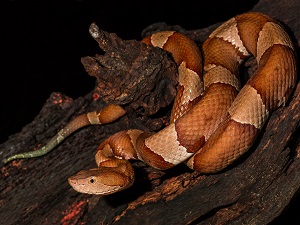Many outdoor workers perform tasks in environments where venomous snakes may be present, and even simple jobs can become dangerous if workers aren’t aware of where snakes hide or how they behave.
Snakes are naturally defensive and will typically avoid people, but bites often occur when a worker accidentally gets too close, steps on a snake, or reaches into an area without realizing one is there.
Snakes may shelter in brush, tall grass, hollow logs, rock piles, lumber stacks, around foundations, in ditches, or along water edges. Because they blend into their surroundings so well, they can be difficult to detect until it’s too late.
Workers in the following roles may have a higher chance of encountering snakes:
- Forestry and logging
- Landscaping and lawn care
- Tree trimming and pruning
- Site clearing and demolition
- Groundskeeping and general outdoor housekeeping
- Road and bridge construction
- Storm cleanup and disaster response
OSHA Standard 1926.21(b)(4) requires employers to train workers in areas where harmful animals are present. Training must cover hazard recognition, avoidance techniques, and appropriate first aid procedures in the event of an injury.
One snake outdoor workers may come across in a variety of environments is the copperhead snake.

Copperhead Snake Identification and Habitat
Copperhead snakes vary in color from reddish-brown to golden tan, with distinctive hourglass-shaped bands across their bodies. These markings often blend perfectly with leaves, dirt, or rocks, making copperheads especially difficult to spot. Adult copperheads typically measure 18 to 36 inches long, though some may grow slightly larger.
Copperheads are found across much of the Eastern United States, reaching as far west as Texas. Workers may encounter copperhead snakes in:
- Wooded areas and forests
- Rocky hillsides or ledges
- Swamps and bottomland hardwood forests
- Near streams, rivers, ponds, or wetlands
- Overgrown or brush-covered job sites
Copperheads are not usually aggressive. Their most common defensive behavior is to freeze and remain motionless when they sense danger, relying on camouflage rather than striking. Unfortunately, this behavior increases the risk of accidental bites and workers often step near a copperhead without realizing it’s there.
Most copperhead bites occur when individuals unknowingly get too close, especially when stepping over logs, clearing brush, or walking through leaf-covered terrain.
Safety Precautions for Avoiding Snake Bites
When conducting safety meetings focused on snake hazards, the following precautions should be emphasized:
- Watch where you place your feet and hands. Snakes hide in brush piles, tall grass, rock crevices, or under debris.
- Wear heavy gloves when removing vegetation, handling lumber, or clearing areas where snakes may be concealed.
- Use sturdy work boots, preferably at least 10 inches high, to reduce the risk of lower-leg bites.
- Stay alert around water sources and heavily vegetated areas, which are prime habitats for copperheads.
- Never try to pick up, disturb, or kill a snake. Many bites occur when someone attempts to “move” a snake.
- If you see a snake, step back slowly and give it room. Copperheads often remain still, which means backing away is usually all that’s required.
What To Do If Someone Is Bitten by a Snake
If a worker is bitten by a snake:
- Call 911 immediately. Treat all bites as serious until proven otherwise.
- Try to identify the snake’s characteristics like the color, pattern, and body shape, but do not risk approaching it. A photo taken from a safe distance can help medical personnel.
- Keep the victim calm and still to slow the spread of venom.
- Position the person so the bite is below heart level.
- Apply a clean, dry dressing over the wound.
- Do not apply ice, cut the wound, use a tourniquet, or attempt to suck out the venom. These methods can cause more harm.
Copperhead bites are rarely fatal with medical treatment, but they can be extremely painful, cause serious swelling, and lead to long-term tissue damage. Quick action and proper first aid are essential.
Keeping Workers Safe in Snake-Prone Areas
With effective training, awareness, and proper precautions, workers can significantly reduce their risk of encountering copperheads and other venomous snakes. Regular safety meetings, clear communication, and ongoing hazard awareness create safer outdoor environments and help ensure every worker gets home safely at the end of the day.
.jpg)

